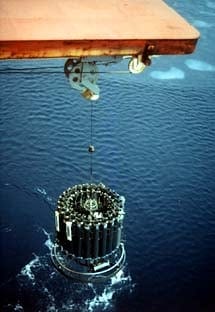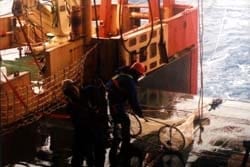Postcards from the Bottom of the Earth: November 22, 2001 (Part 2)
(Note to readers: due to the length of Ken’s first letter to family and friends, it has been broken into two parts. Ellipses ... denote places where the original letter has been excerpted.)
...So why am I spending 45 days out here off Antarctica? (Take notes, the quiz will be emailed later!) Basically the Southern Ocean is one big carbon pump. The ocean plants take up large amounts of carbon dioxide from the atmosphere as they grow. When they sink--my part of the research--they carry this carbon down to the deep ocean. What regulates this carbon pump is a big question in climate studies, particularly the studies of present greenhouse gas levels and of past triggers of ice ages.
There are biologists on board towing nets and water samplers and looking under a microscope at what’s out there. Others are growing phytoplankton (marine plants) under varying conditions of light or nutrients. Most of us chemists have a few compounds we are looking for in seawater, including carbon dioxide, other forms of carbon, and the associated nutrients.
A unique part of this project is that several groups are measuring iron (not an easy feat on a rusty ship), which turns out to be essential to all phytoplankton. Iron is only present at very low levels in seawater down here, since the major source of iron in the ocean is dust carried from land, and there is little land in the Southern Hemisphere. The ice surrounding Antarctica is now melting during this spring/summer season, and as it does so it releases some of the iron that landed last year as dust. We want to understand whether this source of iron stimulates the plankton or not, and how that affects the uptake of carbon dioxide...
My project is to measure a natural compound, thorium, in seawater. Thorium "sticks" to marine particles--phytoplankton, their molts, zooplankton excretions, dead cells-and sinks into the deep ocean, carrying the carbon we are trying to track. Low levels of thorium in the water signify higher removal of carbon. We are early in the growth season here (think May/June up north) and we are seeing some growth of phytoplankton, but little loss of these particles. This will change as we move into different water types, get closer to the ice edge, or sample later in the season...
The hardest part of my work is the simple logistical pain of getting samples. Just the other day, a wall of water hit us unexpectedly and flooded one of the work areas on board. As a result, I lost 17 of 24 sample bottles and a bunch of my gear over the side. The worst of it was when one crewmember got stuck in the room where the water hit. He was hanging on while the water went over his head, but at least he was tied in with a rope to the ship. The crew works under some pretty bad conditions, and unexpected rolls or waves are a common cause of lost gear, bruises, pinched fingers, or worse. I’m now storing my samples in Kraft salad dressing jars from the galley to make up for my lost sampling bottles! And life goes on at the Café Thorium.
Some research groups have a daily “12 hours on, 12 hours off” schedule, similar to our crew. But I’m out here solo for my project, so for me it’s more like "always on," depending upon when we reach sampling stations and what work I am needed to do. Yesterday was a typical 18-hour day of sampling, but now I have some processing for the next 48 hours. At least I’ll get more rest...


